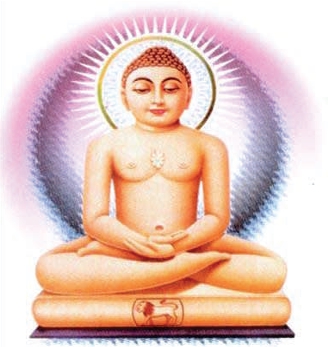
Jainism during Delhi Sultanate could not flourish much as some of the rulers were intolerant. However, many great Jain scholars received honour at the hands of the rulers.
The rulers of Delhi were of Turk origin and followed Islam religion. They were intolerant towards the followers of Jainism and Hinduism. They even indulged in slaughtering of non-Muslims and destroying their property. They demolished temples and idols and tried to convert Indians to Islam. Those who did not accept their instructions were inflicted with pain and torture. However, even under such harsh conditions the Jains were not dejected. Through their practise of forgiveness, submissive and passive conduct they could appease the intolerance and selfishness of these rulers to a certain extent.
During the reign of Muhammad Ghori, Jain Acharya Basantkirti played an important role. Many wealthy Jain families dwelled here. Most of them belonged to the Agrawal caste. Because of the influence, the transcription of `Panchastikaya` was possible during the reign of Ghiyas-ud-din Balban. During the rule of Ala-ud-din Khilji, Thakkur Pandit wrote `Yashodharcharit.` A Digambar Acharya impressed the Sultan by his striking personality and learning. He attained the seat (Patta) of the Mathur Gachcha of the Kashtha sangha in the village Kashtha situated near Delhi. Another Acharya, Prabhachandra of the Nandi Sangha of Digambar tradition came to Delhi and established his position there. Ala-ud-din Khilji, even being a Muslim ruler paid much respect to Digambar Muni Shrutviraswami, Swetambara Suri Jinachandra, and Yati Ramachandra.
In the year 1318 during the reign of Alauddin`s son Qutb-ud-din Mubarak Shah a Jinachandra Acharya of the Khartar gachcha came to Delhi in 1318. He was granted the permission to perform journey to various Jain pilgrimages centres.
During the rule of the Tughlaq period the impact of Jainism was stronger. Jinakushal became the successor of Jinachandra at this time. Ghiyas- ud- din Tughlaq also honoured Thakkur Pheru and granted him the firman for journey to Gujarat teerths. After travelling to various pilgrimage centres Jinakushal reached Sindhu-desh where he breathed his last in 1332 at Devarajpur. His seat was next held by Jinapadma who equally proved influential. Ghiyasuddin had also appointed two Pragvat Jains-Sura and Vira to high posts. He even granted firman or decree to a Shrimal shravaka Gajapati to carry-out his pilgrimages.
After Ghiyasuddin Tughlaq, his son Muhammad Bin Tughlaq ascended the throne and ruled Delhi from 1325 to 1351. He also proved to be a tolerant ruler and respected and honoured many Jain scholars. The Jain shreshthis who transcribed Jain scriptures during this period are, Sahu Badhu, Sahu Mahipala and Sahu Sagia. Many Jain Acharyas like Bhattaraka Durlabhsena of the Kashtha sangha and Bhattaraka of the Nandi sangha, Ratnakirti and his disciple Prabhachandra, and Jinaprabha Suri received great honour and respect from Tughlaq.
The next ruler, Feroz Shah Tughlaq who ruled form 1351-1388 was a fanatic. Thought he was not much tolerant, yet he too paid respect and honoured Jain scholars like Digambar Muni Bhattaraka Prabhachandra, poet Ratnashekhar Suri, Rekha Pandit, specialist in Ayurveda.
Jainism during Sayyid Dynasty
With the fall of the Tughlaqs, the Sayyid Dynasty ruled over Delhi from 1414 to 1450. During their rule the Agrawal shreshthis like Hemraj and Dieuchandra (Diwuta) and Thilha of Bayana (Shripatha Nagar) and some other sahus earned name and fame. They were the disciple of the Bhattarakas Yashahkirti and Gunakirti of the Kashtha sangha. They constructed a chaitya and did sanghayatras effectively. Adhering to their wishes the `Pandava Purana`, Harivansha Purana` were composed in Delhi.
Jainism during Lodi Dynasty
The Lodi Dynasty next came to power in Delhi. The Jain followers received much honour from them. The Afghan rulers maintained cordial relations with them. Bahiol Lodi, the ruler of the Lodi dynasty bestowed a high position to Gada sav, the father of Taran Swami. Gada sav who belonged to Bundelkhand served as one of the officers of the Lodis. He was a revolutionary Jain thinker, who was against idol-worship and all other forms of worship and rituals. He attracted many followers and eventually a separate community of such people were formed. It was named as Sammaiya community. This came to be known as Terapanth.
A Jain shravaka Chowdhari Devaraj became the chief trader of Delhi during the rule of Sikander Lodi. Another Agrawal shravaka, Sadharan was a great scholar and was gifted with high intellect. He had earned the permission of the king to visit different Jain pilgrimage centres. Another Jain poet, Pandit Manikyaraj wrote `Amar Muni Charitra`, and Yayakumar Charitra` during the Lodi period.
Thus during the Delhi-Sultans Jain followers proved zealous and continued to install images and constructed temples. They received much honour and respect at the hands of the rulers.